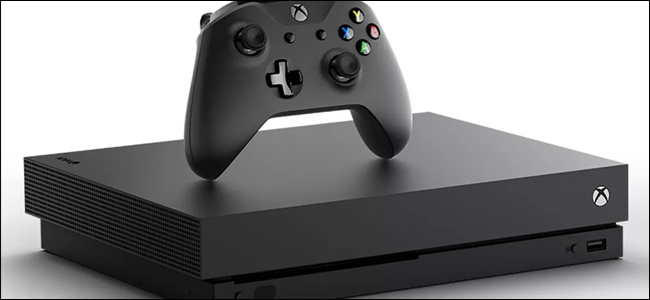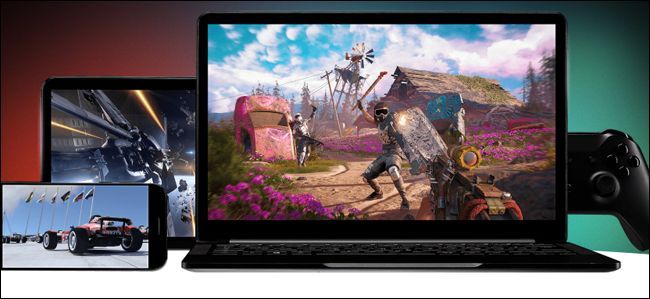Quick Links
The future of game streaming is an open road. But we already have some markets we can use to draw a map: online video streaming services. If we’re not careful, game streaming will hit the same speed bumps.
As Microsoft, Sony, NVIDIA, Google, and others start to ramp up their game streaming subscription services, we can already see what the biggest problem for gamers will be: an increasingly fragmented selection. As platforms and consoles fight to get the biggest and best games on their streaming service, and only their streaming service, gamers will find that it’s impossible to play all the titles they want on just one of them. Not that this is anything new for the gaming industry, of course: it’s the good old-fashioned platform exclusivity problem, now spread out among more and more platforms.
Streaming Looms On The Horizon
To be clear about our terms: the “game streaming” in this article refers to playing video games in your home over a broadband connection, where the actual hardware that hosts the game (the PC or game console doing the number-crunching) is on a server somewhere.
Current examples include PlayStation Now, which streams a selection of PS2, PS3, and PS4 games to either a regular PS4 or a program running on your computer, NVIDIA GeForce NOW, which can stream full-power PC games to either the NVIDIA SHIELD set-top box or PCs, and Google’s Project Stream, which used a single PC game in a test run earlier this year.
We’re not talking about streaming video of someone else playing a game that you watch on a service like YouTube or Twitch.
If you're not familiar with it: game streaming is very cool. It enables someone with minimal hardware, like, say, a $200 SHIELD, to play games that are otherwise limited to a $1000 gaming PC. It doesn’t need local media or massive 50GB downloads, and a relatively small monthly charge can give you access to hundreds of games, a la the Netflix setup. Regarding pure hardware, the only real downer is that you need a solid broadband connection: most of these services recommend 25 Mbps, but I’ve found that they tend to stutter on anything less than 50.
With those pieces in place, the experience is pretty amazing. You can play games at maximum graphical settings with almost perfect sync, including the fastest multiplayer shooters or fighters. And it’s only going to get better and more available: Microsoft is heavily rumored to be developing a streaming-only version of the next Xbox console, the service of which would undoubtedly be available on Windows, too. Even Nintendo is dipping a toe in: the company is currently streaming some older titles to SHIELD owners in China. Predictably, Amazon is looking to get in on this action as well.
Here’s where the “but” comes in.
The Library Problem
Streaming video services are fighting tooth and nail to get original, exclusive content: Netflix has its high-profile Marvel series, conventional shows like Orange is the New Black, and even full theatrical movies like Bird Box. Hulu has exclusives like The Handmaid’s Tale and continuations like The Mindy Project. Amazon Prime video is home to shows like The Marvelous Mrs. Maisel and The Man in the High Castle.
And all of that’s great! These services are becoming powerful production houses in their own right. But if you’re trying to watch one or more shows from each service, as many do in this “golden age of television,” you’re going to have to subscribe to them all. Want the new Star Trek or Twilight Zone shows? Add CBS All Access on top. How about the Teen Titans or Young Justice superhero shows from DC? Add on DC Universe. Want new Marvel and Star Wars shows? There’s that new Disney service coming later this year.
The promise of online TV was a-la-carte watching, with no one ever forced to pay for something they didn’t want, like cable. But a decade later, we have the same cable problem in a new outfit. To get all the TV you want, you’re going to have to pay for a lot of it that you don’t. There are ways around this, like subscribing to one service at a time and binging all of its content, then moving on to the next. But that’s hardly ideal, especially when things like Amazon Prime bundle programming with other Prime services. Most people who watch all their content online are going to need to pay for at least two concurrent services, even if they don’t need access to live TV for sports and news.
This problem is going to apply to streaming game services as well. Now, not only will gamers have to deal with platform-exclusive titles like The Last of Us or Spider-Man on PlayStation and Smash Bros and Zelda on the Switch, they’ll have to juggle which of their games can be played all-online or only locally. Which ones are included in the service fee, and which ones need to be purchased just to play remotely? Flip a coin.
If you’re frustrated with the decentralized nature of premium online TV, wait until you’re doing the same for new $60 games.
Possible Solutions: Console Publisher Requirements And "Renting" PCs
There’s a new console generation due in 2020 or so, at least for Microsoft and Sony. This is generally when battle lines are drawn, and new exclusives are solidified. But assuming both Sony and Microsoft are planning with an eye to focus on game streaming, it’s an opportunity to avoid at least some of this market fracturing.
At the moment, each streaming service has to negotiate with developers and publishers to get games. Once those agreements are made, the service can host games on their backend and deliver them to customers, either as a freebie included with the subscription or an optional all-digital purchase. But as the owners of the Xbox and PlayStation brands, Microsoft and Sony can use a little good old-fashioned corporate strong-arming to make their streaming services stand out.
You see, developers and publishers also have to pay for licenses to release console games---that’s why games on the Xbox, PlayStation, and Switch are generally more expensive than they are on the wide-open PC market.
If game makers want access to the built-in audience on Xbox or PlayStation, Microsoft and Sony can make participation in their streaming services a condition of publishing on their consoles. Want a game released on the Xbox Two or PlayStation 5? Good! You’re also going to make it available for streaming.
This strong-arm approach won't solve the decentralized problem for gamers, but assuming that both Microsoft and Sony implement it in some way for the next generation of consoles, it might at least mean that the transition to streaming games is no more fragmented than the current market. The big industry names will still fight over exclusives, but players won't have to wonder whether that hot new game can be played on their Xbox Stream (or whatever the name might be). Of course, things get more complicated on the PC.
Streaming that relies on PC games is even more decentralized, and services from NVIDIA, Google, and Amazon won’t be able to use that tactic. Take a look at the current library for GeForce NOW for a prime example: it's a scattershot of AAA publishers. Big names like Valve, Ubisoft, Activision-Blizzard, Take Two, and Bethesda are represented, but titles from EA are missing (thanks, Origin) and smaller indie games and older classics are notably thin on the ground. But consumers may be able to benefit from the PC platform in another way. That same wide-open approach is what enables smaller and more competitive services like Shadow.
Shadow allows users to essentially “rent” a virtual high-power gaming PC, and access it from any low-power Windows, macOS, Android, or Linux device, with iOS support coming soon. This solution means you still need to manage game installations and performance yourself, but it makes that gaming content available more or less anywhere you can get a solid broadband connection, with 4K and 144Hz options available, too. Shadow even allows for local and remote backups.
The service is $35 a month and doesn't include an all-you-can-eat library, but the low cost of PC games in sales and bundles can help offset that---a game that goes for $20 or $30 on consoles can often be found for five bucks during a Steam sale. It's a promising and flexible approach, though it might turn off gamers hoping for streaming simplicity.
Streaming games solves some big problems, especially when it comes to cost. If you have an internet connection that can handle it, you’ll have some really exciting options in the near future. You’ll also have a fresh set of annoyances to deal with. The streaming game platform that solves or at least minimizes these annoyances will come out on top.






